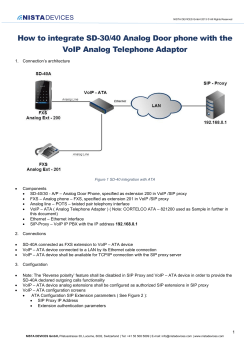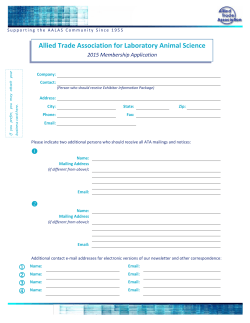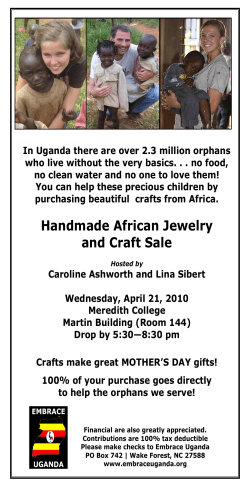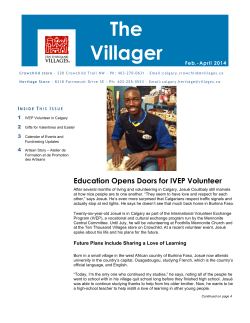
AID TO ARTISANS: BUILDING PROFITABLE CRAFT BUSINESSES
AID TO ARTISANS: BUILDING PROFITABLE CRAFT BUSINESSES NOTES FROM THE FIELD NO. 4 April 2009 This publication was prepared by Aid to Artisans for the Business Growth Initiative Project and financed by the Office of Economic Growth of EGAT/USAID. This report is also available on the Business Growth Initiative project website at www.BusinessGrowthInitiative.org. AID TO ARTISANS BUILDING PROFITABLE CRAFT BUSINESSES Authored by: Marilyn Hnatow, Aid to Artisans Submitted to: USAID/EGAT/EG Contract No.: EEM-C-00-06-00022-00 April 2009 www.BusinessGrowthInitiative.org DISCLAIMER The authors’ views expressed in this publication do not necessarily reflect the views of the United States Agency for International Development or the United States Government. The Role of Crafts in Developing Economies1 Today, in many developing nations, handcraft production is a major form of employment and in some countries constitutes a significant part of the export economy. Observers of the handcraft sector predict that the escalating number of small businesses turning to handcraft production is unlikely to decline significantly in the future. More specifically, artisans have been identified as the second largest sector of rural employment after agriculture in many regions of the world. Handcraft production crosses all sectors of the modern global economy—from pre-industrial to industrial and post-industrial. Artisan production has thrived because handcrafted products offer distinct advantages: minimal start-up capital, flexible work hours, the ability to work at home, and freedom to manage one’s own business. Unlike many other forms of labor, artisan production can also enable a degree of labor autonomy for those who have limited access to the cash economy. As a means of livelihood, handcrafts provide an ideal avenue for creative, independent entrepreneurs. In addition, they offer opportunities for seasonal employment and small production runs, and the sector is often a default occupation for producers who have limited options for employment. According to the Creative Economy Report 2008, arts and crafts are the only creative industry where developing countries have a leading position in the global market.2 For this creative sector, developing-country exports nearly doubled in ten years, increasing from $7.7 billion in 1996 to $13.8 billion in 2005, accounting for 60% of total world exports of creative goods. Tourism and the expansion of leisure and art markets will continue to contribute to the dynamism of arts and crafts in the world market. Developing countries have a leading position in this sector because of their local resources, rich cultural traditions and indigenous designs and products. The trend in the market continues to grow in their favor as consumers and retailers are increasingly demanding handmade, ethically sourced products that are differentiated from mass-production. Artisans have an enormous opportunity to leverage their culture as an asset for economic growth. Efforts to grow this sector will not only foster economic development, but also preserve cultural identity. The Size of the Craft Market Most researchers acknowledge that the lack of a consensus on the definition of handcrafts is a major problem related to tracing the development of handcrafts as a recognized industry, 3 which limits data collection that would provide information on the economic significance of the sector.4 A recent report led by UNCTAD and the UNDP Special Unit for South-South Cooperation, quantified international trade in arts and crafts as totaling $23.2 billion in 2005.5 The report further states: The global market for arts and crafts is expanding and clearly is not negligible; world exports increased 31% during the period 2000-2005, from $17.7 billion in 2000 to $23.2 billion in 2005. Arts and crafts are the most important creative industry for export earnings in developing countries as well as a major item in the exports of developed countries. 1 Ted Barber and Marina Krivoshlykova of Development Alternatives, Inc., 2006, USAID report: Global Market Assessment for Handicrafts. 2 UNCTAD, UNDP Special Unit for South-South Cooperation, 2008, Creative Economy Report. 3 Dormer, 1997, cited in Fillis, 2004, p. 61. 4 Mikkelsen and Hagen-Wood, 1998. 5 UNCTAD et. al, 2008. 1 Even though global statistics are difficult to track, many countries have gathered individual statistics because of the importance and relevance of craft to their economies. Some industrialized countries grant significant importance to crafts. For example, in Italy, 24% of national enterprises belong to the crafts sector, which also employs 1/5 of the private sector workers, among whom 100,000 perform high quality production. Italian crafts exports represent 17% of the GDP.6 In developing countries, the crafts sector is also often given a high level of importance.7 In Colombia, total crafts production represents a yearly income of approximately US $400 million and brings to the crafts workers a monthly income of US $140 to 510. Crafts exports (excluding sales to tourists) amount to US $40 million per year. Every year, 650,000 tourists bring an income of US $800 million to Colombia, of which craft sales represent a major percentage. Two-thousand shops and 400 bulk and export trading companies, employing 800,000 people are directly affected by this important tourism market. Tunisia is an example of a middle-sized country in terms of crafts production. It counts 300,000 craftspeople (11% of the active population) of which 2/3 work on a part-time basis (4 working hours a day). Their production accounts for an average of 3.8% of the Gross Domestic Income and ensures an annual income of US $2,400 per household (an average of 5 members). In Thailand, a study by the Thailand Development Research Institute Foundation (March 2000) estimates that total employment is around 30 million people, out of which 20 million are employed in the “informal sector”. A government Meeting to Alleviate Poverty, held on November 25, 2001, estimated that the population involved in the crafts sector represented around 10% of the aforementioned figures. This includes full time as well as part-time workers, which effectively puts the number of craftspeople around 2 million. The Moroccan Ministry in charge of handcrafts evaluates the number of persons considered as craftspeople in the country to be 20% of the active population. There are 2 million full-time craftspeople, approximately 1 million families living at least partially from handcrafts, and 4,390 exporters.8 Additionally, at an International Workshop organized by UNESCO concerning the collection of data on “Crafts and Tourism”, Morocco crafts generated $6.2 billion.9 Another way to quantify the craft sector is by the size of the end market. The key market for handcraft producers is the home accessories market, which tends to overlap with the “gifts” and sometimes “garden” product categories. The 2007 Universe Study of the U.S. Market by Home Accents Today estimates the market size at $74.2 billion. While it is difficult to determine the share of handmade versus machine-made products in this market, there is anecdotal evidence of a significant increase in mainstream retailers switching to handmade products as a competitive advantage in an increasingly homogenous market. Financial Times recently wrote an article about this growing trend, using IKEA as one example of a mass market retailer looking to developing countries and handmade products for new product collections.10 In addition to home accessories, the market for jewelry and fashion accessories, such as scarves, shawls, handbags and totes, has been growing rapidly due to its expanding availability 6 Noella Richard, 2007, UNESCO, Handicrafts and Employment Generation for the Poorest Youth and Women. Noella Richard, 2007. 8 Dominique Bouchart, 2004, UNESCO Crafts/Tourism Index. 9 Dominique Bouchart, 2004. 10 Helle Juday, Financial Times, March 14, 2009, Crafted with Care 7 2 at all retail levels. Costume jewelry in particular is a fast-growing market, one that is perhaps more accessible to artisans in developing countries. Costume jewelry often uses natural materials such as wood, shell, bamboo, leather, beads, horn, seeds, and recycled materials. Costume jewelry represented 15% of total jewelry sales in 2003 in the EU, accounting for nearly half of all jewelry items sold in volume terms.11 The Lifestyles of Health and Sustainability (LOHAS) consumer market segment will have a large impact on the craft sector; this market segment is focused on health and fitness, the environment, personal development, sustainable living, and social justice. The consumers attracted to this market represent a sizable group in the U.S. Approximately 19% of the adults in the U.S., or 41 million people, are currently considered LOHAS Consumers.12 The National Marketing Institute has projected this market to reach $410 billion by 2010; almost double what it was in 2005, and that 70% of Americans say that they are more likely to support companies that are mindful of their impact on the environment and society. While the LOHAS market is all encompassing as far as product categories, this growing consumer trend of buying ethically sourced and environmentally responsible products is important to the craft sector. Artisans often work with locally sourced raw materials and, with handwork, do not use fossil fuels to produce their products. As consumers become more educated and ask more questions on where their products are coming from, the rich stories that artisans have to tell about their craft, their traditions, and their environmentally and socially responsible production methods will help them gain a competitive advantage. Distribution Channels In order to reach an export market, most artisans work through a traditional distribution channel. The traditional distribution channel consists of artisans, exporters, wholesale importers, retailers and consumers (See Figure 1). In this distribution channel structure, artisans are responsible for producing products and transporting them to an exporter. In addition to quality control, packing the product and transporting goods to the port of exit, the exporter has the responsibility to market the products to wholesalers or retailers. These marketing activities include producing a catalog, establishing and selling at FOB prices, sales meetings with wholesalers and retailers, maintaining an in-country showroom, and customer service. The wholesaler then exhibits in international trade shows, selling the products to retailers at wholesale prices. In order to be a successful wholesaler, these businesses should have a website, full product catalog, and incur all the cost associated with trade show exhibition, which include inventory procurement, transportation to the show, booth display, marketing collateral such as hang tags, brochures and product catalogs, and sales support. After the show, wholesalers follow up with buyers in customer service calls on delivery. They also place any additional orders from exporters, pay for the freight and duty from the country of origin to their warehouse, pick and pack the orders and ship to the individual retailers. Because of increased technology, ease of communication, and more shipping options globally, this traditional distribution channel is flattening. Artisans are becoming more sophisticated and taking on the responsibility of not only producing products, but also exporting them. Additionally, more retailers, even independent retailers and small shops, are buying directly from artisans and taking on importing responsibilities. This flattening distribution channel does put a small incremental amount of profit into the hands of artisan exporters and retailer importers, however, 11 12 CBI, 2004a, p.5. LOHAS.com website 3 it is important to note that even though a player is removed from the distribution channel, the responsibilities and the associated costs are not removed. Figure 1 Assisting Artisans to Build Profitable Businesses Aid to Artisans (ATA) is a nonprofit organization with 33 years of experience in the craft sector working in over 110 countries, having assisted over 125,000 artisans and generated over $230 million in retail sales in the past ten years. Its mission is to create opportunities for low-income artisans around the world to build profitable businesses inspired by handmade traditions. ATA offers access to new markets, business training, eco-effective processes and design innovation through a network of partners to promote sustainable growth and community well-being. ATA blends a passion for the deep-rooted cultures and handmade traditions of the developing world with a commitment to building profitable businesses. Environmentally sound practices are at the foundation of their methodology, recognizing that lasting economic growth can only occur if an integrated approach to product development, business skills training; market access and eco-effective processes are utilized. Product Development Product development encompasses all aspects of a market-ready product: design, technical production issues, costing and pricing, merchandising, packaging, and presentation. 4 Design Traditional artisanry survives only when traditional artisans thrive economically. In order for that to happen, a jolt of attention-getting design is often required. ATA’s product development and designs are rooted in solid market knowledge by hiring successful, trend-forward designers from the U.S. and European home décor, gift, and fashion accessories industries. Their product development aims to blend global An international design consultant market needs with traditional techniques and works with two Guatemalan indigenous motifs. Product design and development weavers. should inspire new possibilities for creative artisan exploration that adds value to their handmade traditions. Through innovation, craft can rise above subsistence into a satisfying and profitable business. Technical Production Design consultants should develop creative solutions to streamline challenges such as raw material preparation, appropriate technology, environmentally sound production methods, and quality control. Producing a sellable product is simply the first step. Producing a product that can be produced repeatedly with consistent quality, affordable costs, care to the planet, and to the health and well-being of artisans is the full recipe for lasting success. They bring in environmental experts to consult on specific issues such as natural dyes, lead-free glazes, and eco-effective processes. Design Mentoring Design consultants should mentor local designers inperson and long-distance to provide market perspective to these in-country creative visionaries. When design Senegalese artisans learn new spinning technique to consultants work side-by-side in an artisan's workshop add value to local cotton accompanied by a local designer, their exchange of ideas products. is invaluable. The exposure of local designers to international market trends is critical to local business sustainability. It allows artisans to be inspired to innovate, design, and produce new products that keep their businesses viable. A case study in Peru in 2005 showed that design innovation played a vital role in the success of an ATA project there. In 1994, Peruvian craft exports were $16 million and declining. This trend was reversed during the course of the project and in 2003, crafts exports reached $30 million. A Peruvian artisan working on new designs of Chulucanas pottery. 5 In addition to working with business savvy exporters to assist rural communities, one of the critical elements of success in Peru was the stunningly fresh designs created by ATA international design consultants. These designers worked with the producers to create new pottery designs, re-interpreting the Chulucanas tradition in a way that was strongly appealing to U.S. buyers. New designs were only the starting point. Technical assistance was imperative to meet new and growing demand. Producers were trained to utilizing new pigments and colors and were introduced to wheel throwing techniques, which in some cases cut production time by a factor of 10. When new designs and technical improvements were implemented, the results were impressive, resulting in at least a million dollars of new sales annually and a visible economic vibrancy in Chulucanas. Marketing ATA's marketing approach is to work with all the partners in the entire distribution channel to ensure sustainability (See Figure 2). Designing market-driven products and business training are only part of the equation. ATA connects artisans, exporters, importers and retailers to ensure that they are working together so that each business along the supply chain becomes profitable. This comprehensive marketing approach forges relationships between artisans and customers that can last for years. Each artisan enterprise is assisted to assess its product and business and to develop actionable marketing plans that define target markets, distribution channel strategy, costing and pricing structures, and sales and marketing activities. Targeting local, regional, or export markets, and determining distribution channels require a focused marketing plan. Artisans new to the global marketplace are offered a unique opportunity to exhibit in ATA booths at the world's largest international trade shows including the New York International Gift Fair, Ambiente and Tendence Lifestyle Shows in Germany, SARCDA in South Africa and the India Handcraft Gift Fair in New Delhi. With their long standing presence in these strategic markets, ATA ensures that participating in these shows will achieve the highest impact and confidence with buyers. Home décor, gift and fashion industries utilize ATA as a resource for connecting their buyers to new materials, products and artisan groups. ATA’s Trade Network is a group of socially conscious businesses that import from artisans affiliated with current or past programs. ATA booth at the New York International Gift Fair. ATA also links artisans and buyers to key account representation in the U.S. These resources include in-country and regional marketing support, buyer trips to artisan workshops, and artisan account meetings to the U.S. Buyer trips. These meetings bring buyers to artisan workshops, allow for face-to-face meetings and the establishment of a long-term business relationship with exporters and other key players. Each artisan enterprise has different goals, needs and factors for consideration in developing the right marketing plan and target market. Most businesses understand that diversification is an important component of continued success as various markets and consumer segments will rise and fall with economic and other factors. Some examples of local/regional and export successes were found in the 2005 Case Studies (discussed in detail below) conducted in Central Asia and Ghana. 6 Central Asia: Regional Strategy: ATA provided national and regional training as part of its business skills services. This included organizational development seminars and business workshops as well as working with local partner non-governmental organizations (NGOs) to provide formal training and one-on-one mentoring in models of democratic governance and financial sustainability. Direct market links were made by bringing artisans to 16 regional craft fairs that were organized in Central Asia during the project, one in Moscow, Russia, and 8 international trade shows. Between 1999 and 2002, these fairs continued to generate income. Artisan groups from all five republics participated in the November 2002 fair; total sales were estimated at $135,000. These fairs continue today and have become destinations for international buyers. Ghana: Multi-Tiered Export Strategy: ATA implemented a four-year project with $1.4 million of funding from USAID. The goal of the project was to increase non-traditional exports, improve artisan livelihoods and communities and continue developing the country’s intrinsic artistry and central position in West African trade routes. Many Ghanaian crafts had disappeared in the U.S. market and there was great potential in bringing those crafts back to that market. Ghanaian exporters exhibited bi-annually at the New York International Gift Fair. ATA, along with the Ghana Export Promotion Council, brought key buyers to Ghana, including Pier 1 Imports, Cost Plus and MarMaxx. Several Ghanaian producers succeeded in supplying not only these large buyers, but also small niche importers of African products, such as Bamboula, Swahili Imports and Tribalinks. Cumulative sales of $859,000 were achieved by project end. Sales continued to increase and surpassed the project budget within two years of end of project and Ghana’s exports increased from $160,000 in 1989 to $11 million in 2002. The Ghana Export Promotion Council credited 60% of this increase as being a direct result of ATA efforts. Figure 2 7 Training Aid to Artisans has comprehensive and relevant training programs in the craft sector. The Market Readiness Program™, held in New York, India, and South Africa, addresses the needs of artisans, exporters, designers, organizational leaders, government officials and cultural preservationists. It is the only craft sector training utilizing industry experts in the fields of product development, design, marketing, environment and business management, providing first hand experience and using real field scenarios. Artisans participate in Internet research training to follow market trends. Many organizations focus on the development and sustainability of market linkages. While market links are vital, a craft business will not become profitable and sustainable if artisans are not trained to develop market links on their own and to innovate in their product collections. Participants are shown how to research global design and market trends on the Internet and how to apply that research to their businesses. Additionally, the training includes developing and cultivating buyer relationships. Overview of Seven Case Studies of ATA Projects ATA received support from the Ford Foundation to develop seven case studies on projects in Africa (Ghana), Latin America (Honduras, Peru), Eastern Europe (Armenia, Hungary, Russia) and Central Asia (Kazakhstan, Kyrgyz Republic, Uzbekistan, Turkmenistan, and Tajikistan) that were initiated between 1984 and 2001. The study showed that ATA’s methodology was generally effective in promoting measurable, durable success in artisan businesses and expansion of a country’s craft sector, even when there was no history of craft export. ATA has also contributed to the establishment of enduring NGOs and networks, preservation of cultural heritage and vitality, women’s development, and environmental stewardship. The studies also showed that lessons learned from previous projects were carried into subsequent projects. ATA sought to examine the impact of its projects over the long term and in a range of different settings. The studies focused on how the craft sectors had changed up to 13 years after the end of the projects. ATA primarily examined measurable economic outcomes, but also focused on less conventionally quantifiable factors important to ATA’s mission or to national development as currently understood—artisan capabilities and skills, women’s development, cultural preservation, and environmental impact. Sites were selected for breadth in geography and craft materials; time since program intervention; and different project foci, including a regional project, preservation of cultural heritage, working with small and medium enterprises (rather than with artisan microenterprises), creation of an organization, and the transformation from an organization to a business. Field research consisted of a team of two people who interviewed artisans, businesses, organization leaders, buyers, consultants, and staff. The teams usually included one ATA staff member and an external researcher or consultant who had worked on the project. 8 Program Outcomes The examples of results below demonstrate the significant economic and organizational contributions of craft development programs and other positive effects on clients and their communities. In Honduras, craft export businesses that started as a result of ATA’s 1984-86 project have generated US$15 million in sales; no artisan businesses existed prior to the project. In Ghana (1993-1997), there are more than a dozen small- and medium-sized artisan exporters that did not exist prior to the ATA Ghana project, and they credit ATA’s design work and US-based training as being pivotal to their success. In Hungary (1991-1995), although many of the cooperatives and master artisans that the project worked with are no longer active, export sales maintained 233 jobs for a decade as a direct result of the project. Russian businesses that worked with ATA have grown, diversified into the local market, survived the 1998 banking crisis, and note that they are more successful than peers who did not participate in the project (1993-1996). In Armenia (1995-1997), where jobs were still scarce more than a decade after the Soviet collapse, a craft-based export business deviates from the norm to pay 200-400 women on time and enable their families to survive. In Central Asia (1994-1999), where government policies inhibit export, the regional fairs that ATA started generate US$150,000 per fair, making them the primary sales venue for many project clients and others. In Peru, craft exports were declining when ATA began working with exporters there in 1994; by 2002, annual exports had doubled and were growing, and exporters gave credit to ATA for much of the turnaround. Investment in development is often slow by nature. Project funders often seek a return of new sales equal to the project funding, which does not always happen during a project. In two projects, sales exceeded the project investment during the life of the project; in three more, the project investment was exceeded within two years of the end of the project; and it was exceeded in four years in the last two. An unwavering dedication that sales at least match budget during the life of the project encourages project planners to avoid working with the poorest of the poor or in places that are difficult for lack of infrastructure or other prohibitive environment. Unanticipated positive outcomes Two significant unintended positive outcomes stand out from the case studies: ATA incubated several US importers as part of its efforts to assist the artisan groups and the craft sector in particular projects. Successful companies such as Volga River Trading (Russia), Sandor Collection (Hungary), and Groovy Holiday (Central Asia) started with ATA guidance and sometimes trade show exhibition space. Dozens of other US businesses have grown based on products and artisans they found through ATA projects. 9 Although ATA’s focus has always been to build businesses, related NGOs and trade associations were founded with ATA support and assistance in Central Asia (CACSA) and Ghana (ATAG), and remain vital. The value of bringing artisans together to learn from each other was most clearly demonstrated in Russia and Central Asia. Strengthening or spinning off local organizations is critical to the development of a commercial craft sector. Lessons Learned Several of the most important and most common lessons from the cases are presented here, although the cases contain many more. Lessons that have been confirmed or incorporated in current projects are included. Changing market requires additional training products: Historically, ATA “handed off” artisan businesses to buyers acquired during the project and little subsequent assistance was needed. However, an increasingly competitive global market compels that clients receive a higher level of training, particularly in product design and in identifying new markets. Teaching innovation as a process is becoming more central to ATA training. Dialogue with the development community is positive: Part of ATA’s learning comes from taking on new tasks presented by funders, sponsors, and members of the larger development community. ATA has successfully maintained its tight focus on the artisan sector, and believes that this has contributed to its success. By combining such new activities with tried and true skills, external and donor pressures have proven to be generally useful experiences for the organization and made lasting methodological contributions to the work, despite sometimes having been challenging to implement. Consultant competencies: Consultants with production expertise (e.g., who are weavers or ceramicists) are more able to design products that reflect the artisan’s production conditions. In addition, rather than using multiple designers, repeat visits from the same consultant result in deeper personal ties and better quality work because the consultant and artisan develop a mutual understanding and ability to communicate and work together. Multiple markets reduce risk: As an American organization, the US market has always been ATA’s primary focus; both funders and artisans are attracted by ATA’s US market network. However, access to multiple markets lowers artisan risk. Product development for North American markets often spills over to upscale expatriate and tourist markets as well. A project is able to target appropriate markets for artisan producers only if staff or consultants have or develop a thorough knowledge of export and local markets. Personal knowledge of market important: Success in the export market is more easily obtained with first-hand knowledge of the market. For both local designers and exporters, understanding and regularly visiting the market and clients is essential to long-term success. Reasonable expectations for results: ATA’s strategy has always been to have timelimited interventions, but project goals need to be realistic for the time frame. In a three year project, a reasonable goal is developing solid export market links, assuming that the craft sector is reasonably organized with existing exporters. The time frame for 10 linking businesses to international markets stretches to five years or more if the export services are missing; if the enabling environment makes business particularly complicated or expensive; or if the craft sector has poor internal connections and mistrust. The goal of building capacity for businesses to develop marketable products and to find new buyers independently is a longer term goal and depends upon successful market links. 11 Bibliography Barber, Ted and Marina Krivoshlykova, 2006. USAID Report: Global Market Assessment for Handicrafts. Development Alternatives, Inc. Centre for the Promotion of Imports from Developing Countries (CBI), 2004a. EU Market Survery 2004: Jewelry. Fillis, Ian. 2002. “Barriers to Internationalisation: An Investigation of the Craft Microenterprise.” European Journal of Marketing 36, no. 7/8. Judah, Helle, March 14, 2009. Craft with Care. Financial Times. Mikkelsen, Lene, and Margaret Hagen-Wood. 1998. Experiences in Taking Crafts to Market. Inter-American Development Bank. Richard, Noella, 2007. Handicrafts and Employment Generation for the Poorest Youth and Women. UNESCO Intersectoral Programme on the Cross-Cutting Theme “Poverty Eradication, Especially Extreme Poverty”. UNCTAD, UNDP Special Unit for South-South Cooperation, UNESCO, WIPO, ITC, 2008. “The Challenge of Assessing the Creative Economy: towards Informed Policy-making”, Creative Economy Report 2008. Websites LOHAS, www.lohas.com Natural Marketing Institute, www.nmisolutions.com 12 U.S. Agency for International Development 1300 Pennsylvania Avenue, NW Washington, DC 20523 Tel: (202) 712-0000 Fax: (202) 216-3524 www.usaid.gov
© Copyright 2026












